|
Service
history
1947
|
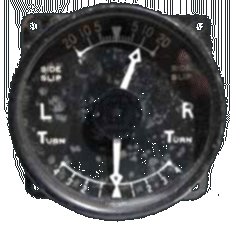
Turn and Bank Indicator of the DH82A |
For 1947 the state of the Tiger Moth fleet did not permit ambitious
plans to be made and it was foreseen that there would only be
training for seven Jr. Lieutenants on the Application Course
starting in May.
Until then, only 611 of A.B. No 2 remained operational. No 613 of
A.B. No 1 only flew four hours in the first four months before she
was sent for overhaul.
On April 30, once the maintenance works were finished, the DGTAG&S
returned four Tiger Moths, 603, 604, 606 and 608 to the EMAer in
flying order. With these, 120 hours were flown during the
Application Course, towards the end of which there was a serious
accident.
On July 4th moments after take-off, 608 lost power and during her
forced landing became entwined in electricity cables running
alongside Route 8. Fortunately, the pilot, Lieut. Jr. Marcelino
García, only suffered slight injuries, but the aeroplane was damaged
to a state considered to be unserviceable. The aircraft had flown a
total of 1,799.8 hours.
To compensate for this loss, the two machines from A.B. No 2 were
loaned for a short time. No 600, which had been under repair since
the previous September, was sent to Pando from the DGTAG&S, whilst
in May 611 arrived, the only Tiger Moth which was still at Durazno.
In fact, neither of these two was used and in August, once the
Application Course finished, they were posted back to the DGTAG&S
together with 603, 604 and 606.
The positioning flight of these five aircraft was the last operation
of the Tiger Moths from Pando. Their take-off, destination Paso de
Mendoza, was the very last movement of biplanes in the service of
the Military School of Aeronautics.
|
No |
Date |
Pilot |
Route
|
| 600 |
1 Ago. |
Alf.
Jorge Borad |
E.M.Aer.
– B.A.Nº1 |
| 603 |
13
Ago. |
Alf.
Jorge Borad |
E.M.Aer.
– B.A.Nº1 |
| 604 |
13
Ago. |
Alf. Federico
Ortiz |
E.M.Aer.
– B.A.Nº1 |
| 606 |
13
Ago. |
Tte2º
Walter Gianarelli |
E.M.Aer.
– B.A.Nº1 |
| 611 |
22
Ago. |
Tte2º
José Mª Mazzetti |
E.M.Aer.
– B.A.Nº1 |
Last flights of the Tiger Moths at the EMAer.
As from September, the last nine surviving Tiger Moths were all at
Boiso Lanza and of these, only 600, 603 and 613 were still in flying
order.
With these
three machines and 2nd Lieut. Humberto Bia as instructor, a brief
refresher training was given to Corporals Washington Galarza, Carlos
Ferraro, Felix Arroqui, Tabaré Galvez, Omar Garcia and Wilson Lorda.
To these six
pilots a new mission was assigned flying the DH82A, that of aerial
fumigation.
During those
years the north east of the country was affected by great waves of
locusts arriving from Brazil, which ruined vast areas of plantations
during their passage.
In order to
combat the plague, the “Aerial Service of the Fight against Locusts”
was organized using a combined force of civil and military aircraft
and pilots.
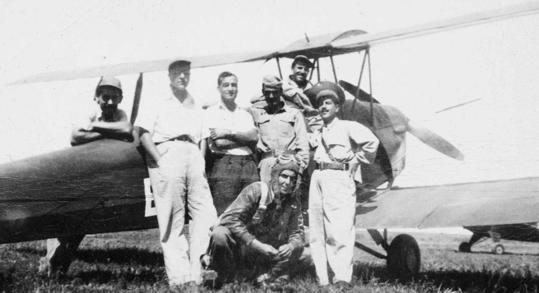
Having a
break. Mixed crews pose together next to the Tiger Moth during the
fumigation operations. Behind is a civilian aircraft assigned with
the same task. Cerro Largo, 1947 - Photo FAU Archive
The available Tiger Moths were adapted for their new function by the
installation of a tank, made to measure and fixed inside the rear
cockpit. The system was manually operated by the pilot occupying the
front seat using a rudimentary mechanism which released the
chemicals through a chute in the floor.
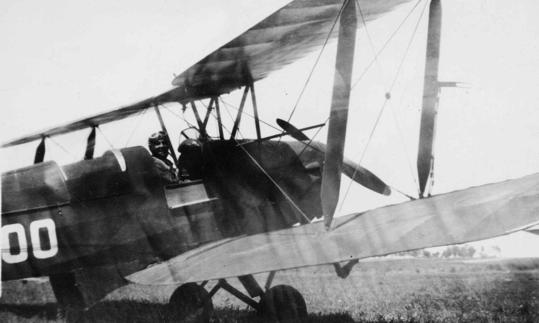
A shot of
E-600 illustrating the tank for the agrochemicals in the rear
cockpit and the rudimentary chute adapted below the fuselage.
Photo Aeronautical Museum
On October 14,
during one of his training flights at the Capt. Boiso Lanza Military
Aerodrome, Corporal W. Lorda had an accident with 613. Luck was on
the pilot's side as he escaped unharmed, but the aeroplane was
seriously damaged and was written off after logging 1,489.7 hours.
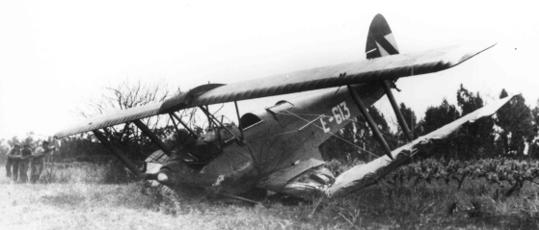
The
condition of 613 after the accident on October 14 at the Capt. Boiso
Lanza Military Aerodrome.
Photo FAU Archive
On the following day, we can record another significant flight in
the life of the Tiger Moth by the now General Berisso, Aeronautical
Arms Inspector. He did this when he flew 603 for 20 minutes and
became an entry in the Flight Logs of the DGTAG&S.
Returning to
the anti-Locust operation, between 25th and 26th October, Private
Tabaré Galvez flew 16 hours combating the enemy “air-to-air” in 600,
near the villages of Sarandi del Yi, Blanquillo, La Paloma (Durazno)
and San Gregorio.
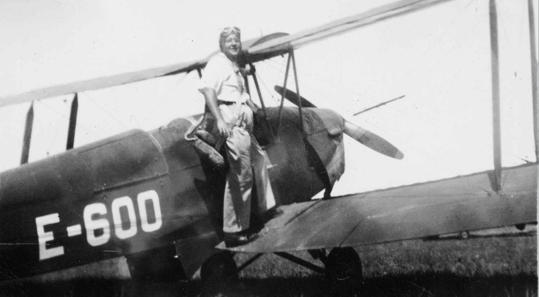
No
600 assigned to fumigation tasks still retained the ' E' in her
serial, although the aeroplane no longer beloneds to the EMAer.
Durazno, 1947 - Photo Aeronautical Museum
In his turn, Private Omar García worked on the operation all through
November, spraying for over 60 hours with No 603 in Melo, Yaguarón,
Río Branco, Treinta y Tres, Santa Clara, Laguna Merín, Arrocera 33,
Aceguá, Capilla Farruco, Arroyo Cardales, Fraile Muerto and Durazno.
On December
18, whilst performing this task, 600 was lost in an accident in
Mazangano, a district of Cerro Largo. Her pilot, Corporal T. Galvez,
fortunately was unharmed. The machine, still bearing the serial
prefix “E”, was written off having recorded 1,804 hours, reducing
the Tiger Moth fleet to seven.
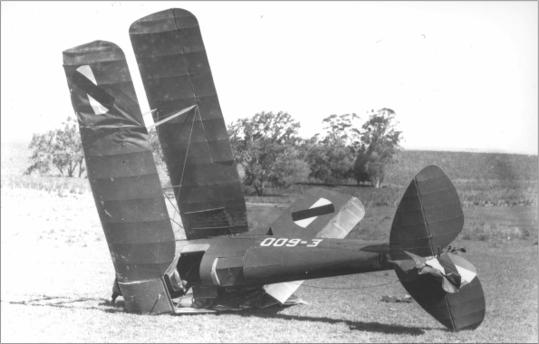
Finale for
600 (c/n 3312). The sad scene reveals the pesticide tank fitted into
the rear cockpit and the ingenious “toboggan” exit underneath the
fuselage. Mazangano, Cerro Largo, December 18, 1947 - Photo
Aeronautical Museum
Towards the end of November, 605 was ready to emerge from the long
overhaul begun 18 months beforehand. The aircraft also was modified
for fumigation and was sent to Ombúes de Lavalle in the district of
Colonia, where Corporal Omar Garcia flew for eleven hours, including
the return to Boiso Lanza on 20th December. This was the aircraft's
last recorded flight.
The
deactivation of 605 was ordered, together with that of the other
three which had suffered accidents in the same year; 600, 608 and
613, through the DGAM Order of February 18, 1948.
No 605 was the
DH82A that had flown most, 2,129.7 hours, without major incidents up
until the moment of her withdrawal.
The Tiger Moth
fleet finished the year with 420 flying hours and only six
aeroplanes on the inventory, regrouped at Boiso Lanza under the
administration of the DGTAG&S.
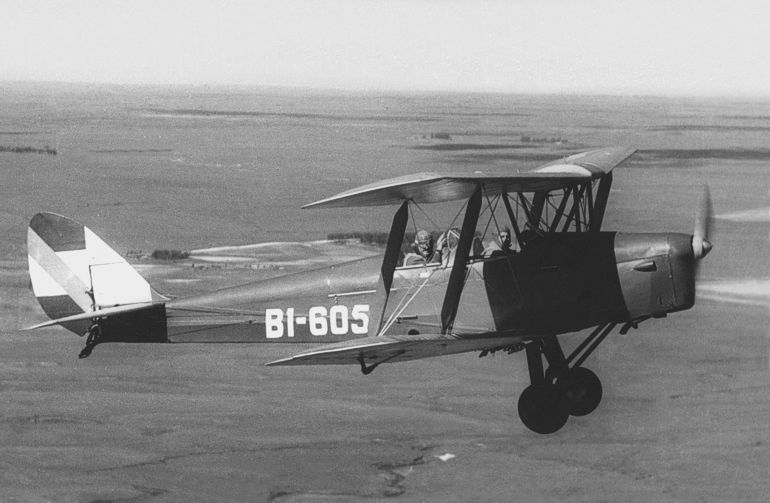
No 605
photographed in September 1945, when she formed part of the
equipment of Aerial Base No 1. It was this aeroplane that had flown
the highest number of hours in the fleet. - Photo FAU
Archive
|